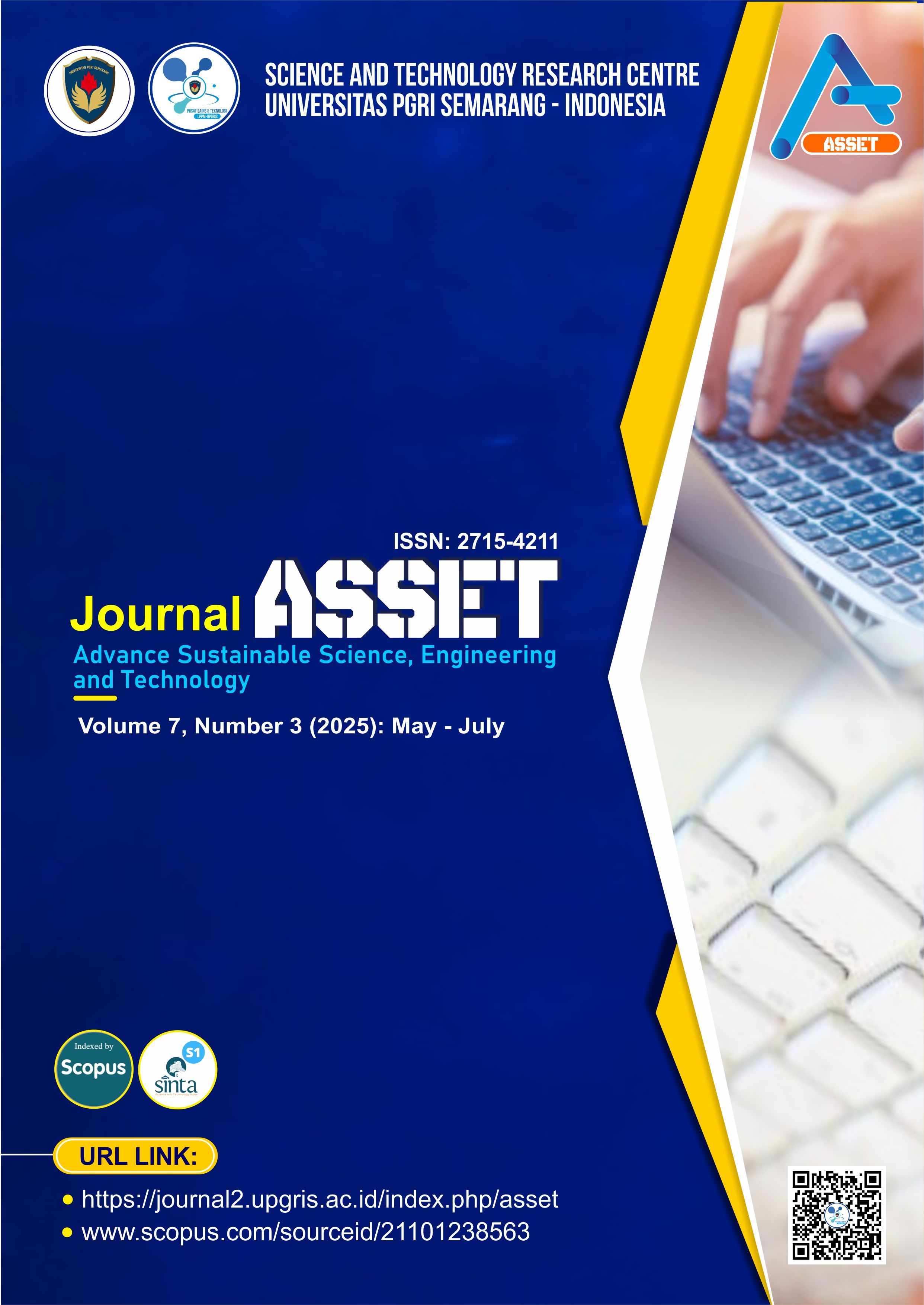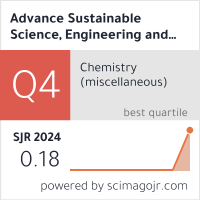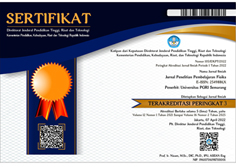Evaluating the Role of Extractives in Biomass Pyrolysis for Enhanced Hydrogen Syngas Production
DOI:
https://doi.org/10.26877/asset.v7i3.2132Keywords:
biomass pyrolysis, extractive content, hydrogen yield, syngas qualityAbstract
This study explores how extractive content in lignocellulosic biomass affects syngas quality during fixed-bed pyrolysis-gasification, specifically focusing on hydrogen (H₂) concentration. While woody biomass is a known energy source, the link between its non-structural organic compounds (extractives) and H₂ in syngas is often overlooked. We investigated teak, coconut, and jackfruit wood to understand this influence and optimize temperature for better biomass-to-hydrogen conversion. An MQ-8 sensor detected H₂ levels. Results show that biomass with high extractive content significantly boosts syngas H₂. Jackfruit wood yielded the highest H₂ concentration (2898 ppm at 471°C), outperforming coconut wood (1965 ppm at 444°C) by 41.7% and teak wood (1931 ppm at 395°C) by 50.1%. This is due to jackfruit's high cellulose and extractive content, which decompose efficiently at higher temperatures. Overall, high-extractive biomass improves syngas quality and expands sustainable options for hydrogen production.
References
[1] H. A. M. Salman, R. A. Wahyuono, and T. Warsokusumo, “Optimizing Biomass Pre-Treatment Technologies for BBJP Plants in Indonesia: A Multi-Criteria Decision Making Approach,” Adv. Sustain. Sci. Eng. Technol., vol. 6, no. 1, 2024.
[2] Alwahab et al., “Optimization of Biogas Liquid Waste from Livestock Manure as a Source of Renewable Energy through Microbial Fuel Cell (MFC) Technology,” Adv. Sustain. Sci. Eng. Technol., vol. 6, no. 2, 2024.
[3] D. I. Setyanansyach, M. Setiyo, and T. Raja, “Review and Bibliometric Analysis of Biogas Power Plants in Indonesia,” Adv. Sustain. Sci. Eng. Technol., vol. 5, no. 3, 2023.
[4] M. A. Hamad, A. M. Radwan, D. A. Heggo, and T. Moustafa, “Hydrogen rich gas production from catalytic gasification of biomass,” Renew. Energy, vol. 85, pp. 1290–1300, 2016.
[5] V. S. Sikarwar et al., “An overview of advances in biomass gasification,” Energy and Environmental Science, vol. 9, no. 10. pp. 2939–2977, 2016.
[6] F. U. Aditya and A. Rahmadi, “Study of Potential Waste of Sawn Timber Processing in Banjarmasin Utara District and Banjarmasin Barat District the City of Banjarmasin Province of Kalimantan Selatan,” J. Sylva Sci., vol. 02, no. 5, pp. 854–864, 2019.
[7] E. H. Herraprastanti, M. A. Ashraf, R. Wahyusari, and D. Y. Alfreda, “Fuel from plastic waste using the pyrolysis method,” in BIS Energy and Engineering, 2024, vol. 1, p. V124011.
[8] A. Nugroho, M. A. Fatwa, P. D. Hurip, H. Murtado, and L. Kurniasari, “Pyrolysis of plastic fishing gear waste for liquid fuel production: Characterization and engine performance analysis,” in BIS Energy and Engineering, 2024, vol. 1, p. V124040.
[9] D. Dayton, “A review of the literature on catalytic biomass tar destruction,” 2002.
[10] V. Kirsanovs, Wood Chips Gasification. .
[11] F. D. F. Chuahy and S. L. Kokjohn, “High e_ciency dual-fuel combustion through thermochemical recovery and diesel reforming.,” Appl. Energy, vol. 195, pp. 503–522, 2017.
[12] M. Zhao et al., “Alkali metal bifunctional catalyst-sorbents enabled biomass pyrolysis for enhanced hydrogen production,” Renew. Energy, vol. 148, pp. 168–175, 2020.
[13] S. Zhang, S. Zhu, H. Zhang, X. Liu, and Y. Xiong, “High quality H2-rich syngas production from pyrolysis-gasification of biomass and plastic wastes by Ni–Fe@Nanofibers/Porous carbon catalyst,” Int. J. Hydrogen Energy, vol. 44, no. 48, pp. 26193–26203, 2019.
[14] T. Suprianto, W. Wijayanti, and I. N. G. Wardana, “Synergistic effect of curcumin and activated carbon catalyst enhancing hydrogen production from biomass pyrolysis,” Int. J. Hydrogen Energy, vol. 46, no. 10, pp. 7147–7164, 2020.
[15] B. Pandey, Y. K. Prajapati, and P. N. Sheth, “Recent progress in thermochemical techniques to produce hydrogen gas from biomass: A state of the art review,” Int. J. Hydrogen Energy, vol. 44, no. 47, pp. 25384–25415, 2019.
[16] M. Nasir Uddin, W. M. A. W. Daud, and H. F. Abbas, “Potential hydrogen and non-condensable gases production from biomass pyrolysis: Insights into the process variables,” Renew. Sustain. Energy Rev., vol. 27, pp. 204–224, 2013.
[17] A. P. Heriyanti, B. Sitty Nur Syafa, and J. Abdul, “Exploring Biochar Briquettes from Biomass Waste for Sustainable Energy,” Adv. Sustain. Sci. Eng. Technol., vol. 7, no. 3, 2025.
[18] D. Chen et al., “Insight into biomass pyrolysis mechanism based on cellulose, hemicellulose, and lignin: Evolution of volatiles and kinetics, elucidation of reaction pathways, and characterization of gas, biochar and bio‐oil,” Combust. Flame, vol. 242, 2022.
[19] T. Xu, X. Zheng, J. Xu, and Y. Wu, “Hydrogen-Rich Gas Production from Two-Stage Catalytic Pyrolysis of Pine Sawdust with Nano-NiO/Al2O3 Catalyst,” Catalysts, vol. 12, no. 3, 2022.
[20] M. Morel-Rouhier and R. Sormani, “Wood degradation and ligninolytic fungi,” in Advances in Botanical Research, 2021.
[21] J. L. L. N’Guessan, B. F. Niamké, N. J. C. Yao, and N. Amusant, “Wood Extractives: Main Families, Functional Properties, Fields of Application and Interest of Wood Waste,” For. Prod. J., vol. 73, no. 3, pp. 194–208, 2023.
[22] Y. Peng et al., “Analysis of pyrolysis behaviors of biomass extractives via non-linear stepwise heating program based on Gaussian multi-peak fitting of differential thermogravimetric curve,” Thermochim. Acta, vol. 702, p. 178976, 2021.
[23] M. Poletto, “Effect of extractive content on the thermal stability of two wood species from Brazil,” Maderas Cienc. y Tecnol., vol. 18, no. 3, pp. 435–442, 2016.
[24] Y. Qiao et al., “Valorization of Vegetable Waste via Pyrolysis: Thermal Behavior, Volatiles Release, and Products Analysis from Its Extractives,” Energy and Fuels, vol. 34, no. 2, pp. 1896–1907, 2020.
[25] A. N. Fauzan, “SIFAT ANTI RAYAP ZAT EKSTRAKTIF KAYU TERAS CEMPEDAK (Artocarpus champeden Stokes) TERHADAP SERANGAN RAYAP TANAH Coptotermes curvignathus Holmgren ADE,” no. July, pp. 1–23, 2020.
[26] F. Maulida, K. B. Meiganati, and M. Maslahat, “KOMPONEN KIMIA KAYU TRUBUSAN JATI UNGGUL NUSANTARA (Tectona grandis Linn.f.) PADA BAGIAN PANGKAL, TENGAH DAN UJUNG,” J. Sains Nat., vol. 10, no. 2, p. 55, 2020.
[27] Ganis Lukmandaru, R. A. Mohammad, P. Wargono, and V. E. Prastyo, “Studi Mutu Kayu Jati di Hutan Rakyat Gunung Kidul,” J. Ilmu Kehutan., vol. 51, no. 1, p. 51, 2016.
[28] S. Komarayati and P. Hastoeti, “Analisis Kimia Kayu Nangka dari Jawa Barat,” J. Penelit. Has. Hutan, vol. 11, no. 8, pp. 326–328, 1993.
[29] I. Y. Wardhani, S. Surjokusumo, Y. Sudo, and N. Nugroho, “Distribution of Chemical Compounds of Coconut Wood ( Cocos nucifera L ),” J. Trop. Wood Sci. Technol., vol. 2, no. 1, pp. 1–61, 2004.
[30] M. Brebu and C. Vasile, “Thermal degradation of lignin - A review,” Cellul. Chem. Technol., vol. 44, no. 9, pp. 353–363, 2010.











